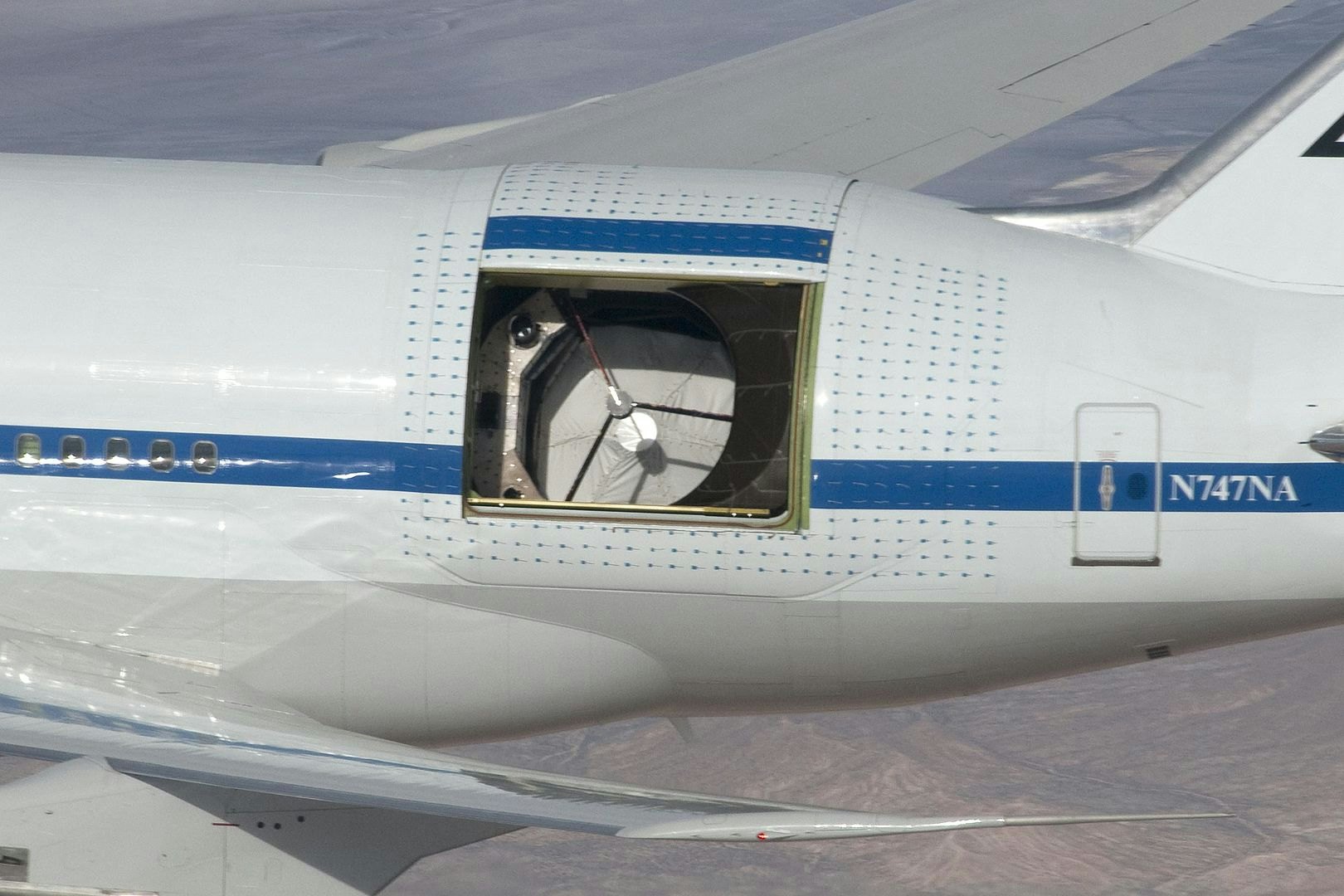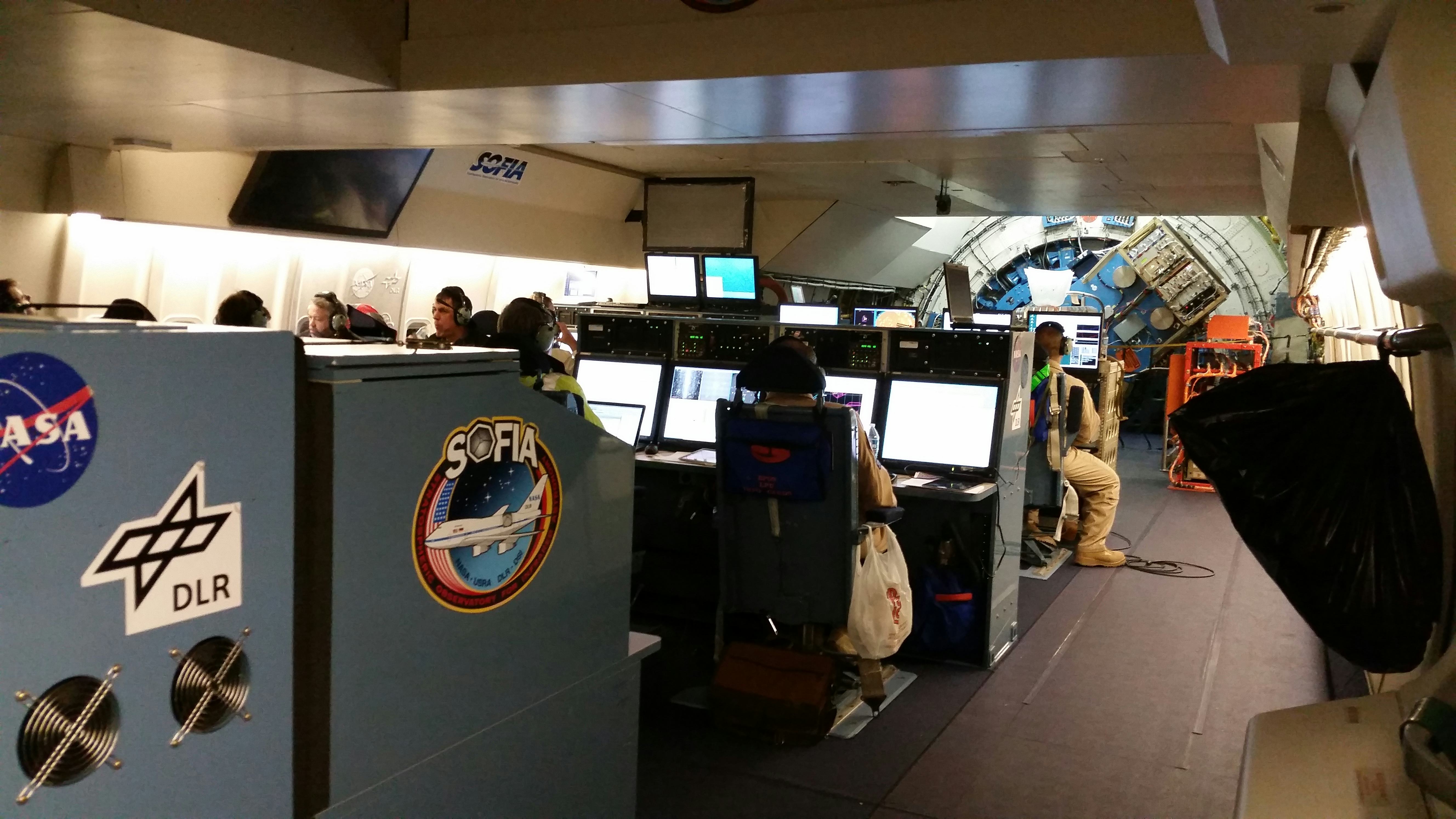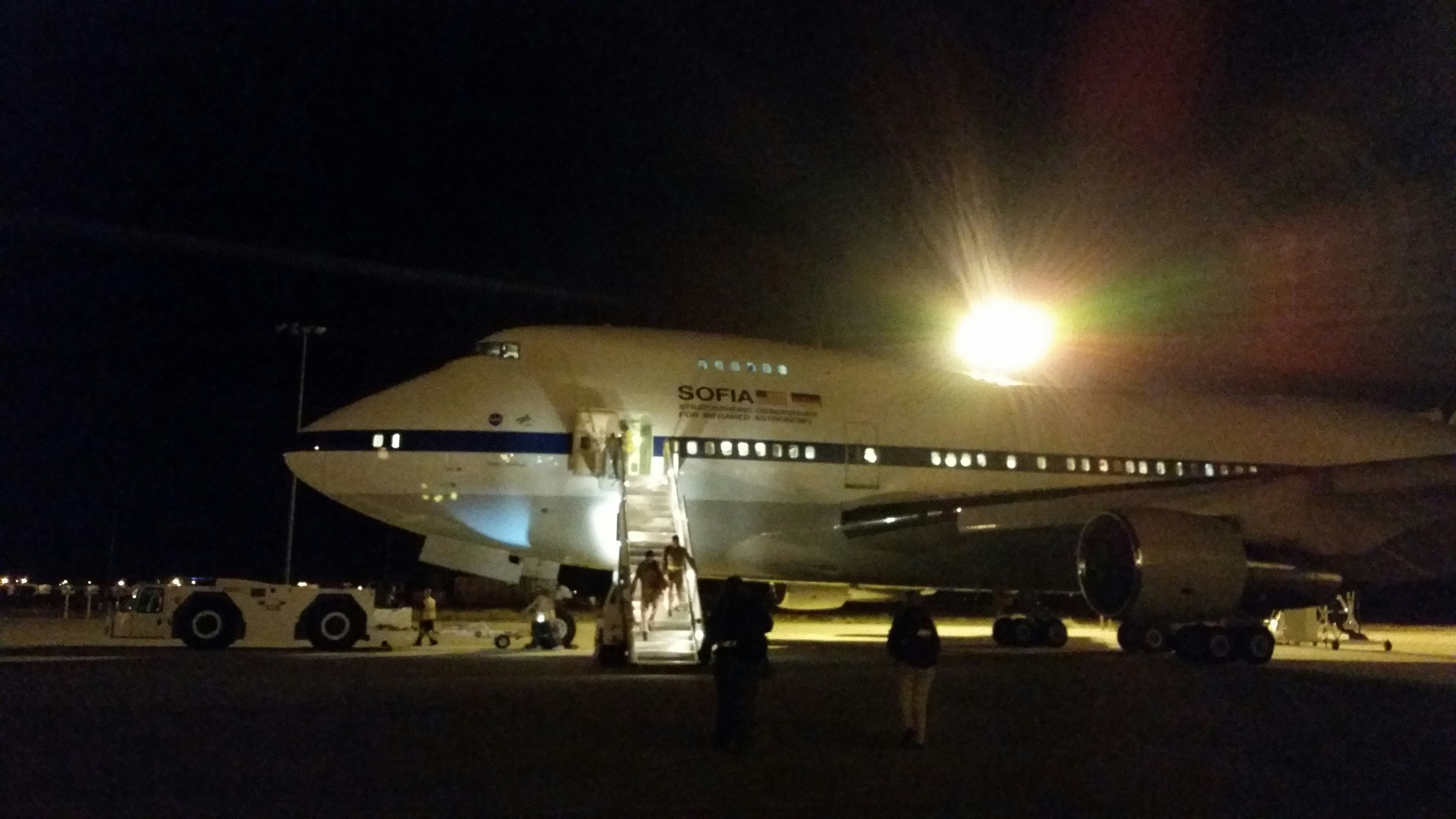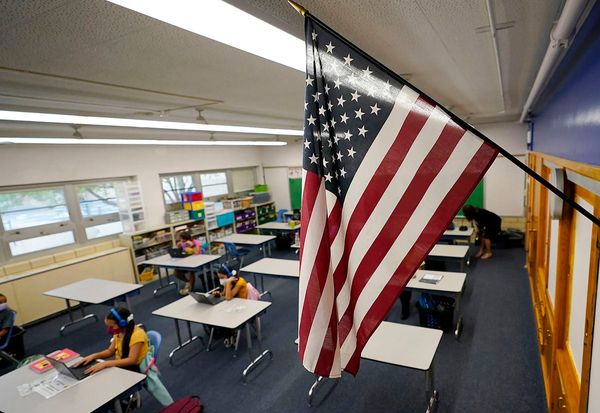
It was a dark, clear October night in 2015, and from 41,000 feet over the Pacific Ocean, the sky above seemed to overflow with stars. Even from the cabin door, peering over the pilots’ shoulders to see out the Boeing 747’s cockpit windows, the sky was a dazzling sight. But more importantly, this leg of our flight path was the perfect vantage point for viewing a distant supernova remnant through the infrared telescope mounted just behind the jumbo jet’s wings — a typical night aboard NASA’s flying telescope.
Now, NASA’s Stratospheric Observatory for Infrared Astronomy or SOFIA mission is over. The 747 touched down after its last flight in the predawn hours of September 30, 2022, about five months after NASA announced the end of the program. Inverse looks back at NASA’s flying telescope, relives a routine science flight on SOFIA, and looks ahead at what’s next for far-infrared astronomy.

NASA’s flying telescope — Like the James Webb Space Telescope, SOFIA viewed the universe in infrared light, whose wavelengths are just slightly too long for our eyes to see. Infrared telescopes shed light on distant galaxies, the births and deaths of stars, and the worlds of our own Solar System. But unlike Webb or anything else in astronomers’ repertoire today, SOFIA could see the longest wavelengths of infrared light, called far infrared.
Telescopes like the European Southern Observatory’s VISTA in Chile or NASA’s Infrared Telescope Facility in Hawai’i, perched high on mountaintops, can see in some infrared wavelengths, but to see in far -nfrared, a telescope needs to get above even more of the atmosphere.
Putting the telescope in space is one way to accomplish that, and in fact, it’s the option the recent Astrophysics Decadal Survey recommends as more cost-efficient. But installing a telescope aboard a modified 747 also does the trick.
“It's such a different mission than any other NASA mission,” Naseem Rangwala, SOFIA project scientist, tells Inverse in 2022, a few days after SOFIA’s final flight. “It's a crewed mission, so it heavily relies on our relationship and trust with each other. And that will last forever.”
In 1995, NASA bought a Boeing 747 widebody — specially designed for long-range, high-altitude commercial flights. Engineers fitted out a compartment just aft of the plane’s wings to house the telescope’s 8.8-foot wide primary mirror and 8.2-foot wide secondary mirror. An 18-foot-tall, 13-foot-wide sliding door on the left side of the fuselage could open, even while cruising at hundreds of miles per hour, to give the telescope a view of the night sky, while a sturdy pressurized bulkhead protected the rest of the cabin.
SOFIA took its first flight in 1997. By then, the aircraft with the new call sign NASA747 was already a venerable commercial flyer, having flown since 1977, first for PanAm and then for United Airlines. It would be NASA’s successor to its flying telescope, the Kuiper Airborne Observatory or KAO: an infrared telescope mounted in a Lockheed C-141A.
While the 747 that would eventually become SOFIA was ferrying passengers around the globe, KAO was helping astronomers discover the rings around Uranus (stop laughing), the atmosphere of Pluto, and the fusion of heavy elements in the fires of supernova SN1987A. NASA had flown KAO since 1974, when it took over for the agency’s first flying telescope, the Galileo Observatory: a modified Convair 990.
The end of the SOFIA program appears to mean the end of airborne astronomy at NASA, at least for the foreseeable future.
Memories gone by — On an early evening in October 2015, myself and a group of SOFIA astronomers had left NASA’s Armstrong Flight Research Center, curving over Los Angeles on our way out over the ocean into the setting sun. The flight, like all of SOFIA’s flights, was a 10-hour all-night astronomy marathon. Most ground-based telescopes parcel out their time to astronomers in whole nights, but SOFIA handed out observing time an hour here, two hours there.
“It's more like a space telescope, in that Hubble in one day will do six or seven different astronomers' projects,” said Dana Backman during the 2015 flight. He was then SOFIA’s outreach director and principal investigator at NASA’s Airborne Astronomy Ambassadors Program.
On that flight, the telescope had a packed to-do list. After some calibration images, SOFIA would gather data on the supernova remnant Cassiopeia A for an astronomer at Leiden University. Afterward, it would observe a dense cloud of gas and dust in the constellation Serpens for University of Illinois astronomer Leslie Looney, who was studying how and where energy leaked out of the cloud, which increased the chances it would collapse into a star.
“Everybody knows that stars form by (the) collapse of interstellar clouds, but the details are pretty much uncertain,” explained Backman.

In nearby galaxy NGC 253, SOFIA would observe the same process at a much larger scale for University of Stuttgart (and German SOFIA Institute) astronomer Alfred Krabbe. NGC 253 is churning out new stars at a staggering speed: about 1,000 every year, about 100 times the Milky Way’s more sedate production. Krabbe was also managing the calibrations of what was, at the time, a brand-new astronomy instrument called FIFI-LS, the Far Infrared Field Imaging Line Spectrometer.
Pointing SOFIA at each new target meant turning an entire plane around — and being in the right place at the right time as objects moved across the night sky.
“They have a massive scheduling software program that tries to plan out a year's worth of these observations, and in any one given night, we put observations together that take us on a path from Palmdale, around the sky, and back to Palmdale,” said Backman. “For each object, the plane has to fly a different heading, because you're pointing the telescope by turning the plane.”
In fact, that night’s complicated flight path had already confused Air Traffic Control back in Los Angeles, who weren’t used to aircraft zigzagging in and out of their airspace. That’s when I learned that while NASA usually prefers to work with air traffic controllers for everyone’s safety, they don’t technically have to. And sometimes, it takes a satellite phone call from somewhere over the Pacific, just out of radio range, to clear things up.
That complex planning — and the double-headed task of simultaneously running an observatory and flying a jumbo jet — needed coordination from the flight’s mission directors, teamwork from everyone on board, and a lot of coffee courtesy of the safety team.
Everyone on board had work to do. Astronomers were busy preparing for their turn on the telescope, watching their data pouring in, or starting to check the data they’d gathered. Software engineers Bill Wohler and Melanie Clarke, who between them wrote the code that controlled the telescope and its instruments and reduced SOFIA’s raw data into a usable format, spent the flight monitoring their software and troubleshooting on the fly (literally) if something got off-track.
At his console, science instrument operator Christopher Trinh was doing exactly what his title implied, with the extra work of explaining everything to a curious reporter. Meanwhile, the mission directors kept the night’s packed schedule of observations on track and coordinated between the observatory on the plane’s main deck and the pilots in the cockpit, resulting in a constant flow of communication in the headsets as the mission directors called for slight changes to headings or angles.
Airborne astronomy is like regular astronomy, but a lot louder — For the most part, SOFIA’s cabin looked more like a working science lab than a passenger cabin, except that everyone wore headsets, and when I briefly took mine off, I was immediately surprised by the sheer volume of the white noise in the background. Most people, even seated next to each other at the same workstation, used the headset radios to communicate. It was easier than shouting, unless a visiting reporter needed a recording. Then we all shouted amiably at each other about science.
Rows of seats and computer consoles mostly faced the back of the plane — and the telescope.

Although the telescope’s mirrors sat in their open compartment, protected from the plane’s constant vibration by a system of oiled bearings and squishy rubber dampeners, the rest of the telescope extended through the bulkhead and into the cabin.
Trinh pointed out specific parts of what looked like a sci-fi set assemblage of metallic parts, wires, tubes, and blinking lights. Those parts turned out to belong to the liquid nitrogen and helium system that kept the telescope cooled to a chilly 2 Kelvin, the scientific instruments, and the telescope’s “camera” itself (easy to spot on my flight because it had been decorated with a plastic jack o’lantern).
“Whenever we're in any sort of turbulence, it will look like the telescope is bouncing around a lot, but it's actually stable and pointing where we need it to,” explained Trinh. “It's actually the entire aircraft that's moving around the telescope.”
“You don’t know how to fly this 747.” — Everything on board SOFIA moved around the telescope, literally and figuratively.
“Everything we do has a reason that's based in the science, and that's what a lot of the new pilots take a long time to understand, because they come in with the thought of, ‘Well, I know how to fly a 747,’” said pilot Troy Asher that night in 2015 (he’s now the director for flight operations at Armstrong). “And the first thing you tell them is, 'well, you don't know how to fly this 747.'” Every decision about flying the massive jetliner was based on where the astronomers on the main deck needed the telescope to point, and when, and at what angle — the crucial difference between flying an observatory and flying a passenger jet.
When people talk about pilots “pushing the envelope,” they’re usually talking about sleek, agile fighter jets – not enormous commercial airliners. But SOFIA’s pilots pushed the 747’s envelope on a regular basis to fly about 5,000 feet above commercial airline routes. That altitude put the telescope above most of Earth’s atmosphere, where water vapor tends to absorb most of the incoming infrared radiation and block it from reaching telescopes on the ground.
But it also made the winged observatory harder to fly.
“It’s a lot less responsive at higher altitudes. If you bank too much, or if you just make any sudden motions, it really affects your situation,” Asher said. “If you make a mistake, you can’t fix it. You have to descend to a lower altitude to make up for whatever mistake you made, which messes up the observations.”
NASA’s press materials claim the open telescope compartment doesn’t change the flight performance of the aircraft, and Asher told me the same thing — while flying with the telescope door open.
“We fly the plane like we always do, and we don't notice when the door comes open,” he said. “We know we opened it, so we know it's open, but we don't feel it. There's no rumbling. You didn't feel it, right?” I nodded; there had been nothing but the steady slight thrumming of the deck below my feet the entire flight.

The sun sets on SOFIA — In its 25 years and 291 flights, SOFIA helped astronomers study the feeding of supermassive black holes, the explosive deaths of massive stars, and the formation of new stars. SOFIA’s instruments also found traces of helium hydride, the first molecule formed in the early universe; models had predicted its existence for years, but SOFIA was the first telescope to spot evidence of it in space.
Astronomers used SOFIA to study the nearby exoplanet system Epsilon Eridani, which looks remarkably like our Solar System and orbits a Sun-like star. Surprisingly, SOFIA discovered that the system has an asteroid belt — in about the same spot as the one in our own Solar System.
“The similarity of the structure of the Epsilon Eridani system to our solar system is remarkable, even though Epsilon Eridani is much younger than our sun,” explained a NASA press release in 2019.
And in 2020, SOFIA helped astronomers discover water trapped in lunar regolith, even outside permanently shadowed areas of the Moon's surface. Earlier this year, astronomers announced that they'd found more water in the Moon's southern hemisphere, one of the areas that may turn into a hotspot for future crewed missions to the Moon.
But NASA officials, along with the National Academy of Sciences (whose Decadal Surveys give NASA an important check-in on science priorities for the coming decade), had begun to worry that the $85 million-dollar-a-year flying telescope wasn’t delivering enough to justify the price tag.
The Astrophysics Decadal Survey, released in late 2021, recommended grounding SOFIA by 2023, citing “high cost and modest scientific productivity.” At the same time, the Decadal Survey also suggested adding a far infrared space telescope to NASA’s list of priorities for the coming decade. A space telescope, in other words, would give NASA more scientific bang for its buck.
By the time the Decadal Survey came out, NASA had already suggested cutting the flying telescope from its budget for the 2021 fiscal year (which, for arcane reasons of finance, runs from October 1 to September 30), but Congress decided to keep SOFIA flying for another year anyway. The same thing happened in the fiscal year 2022 budget.
At last, in April 2022, NASA announced that September 30, the last day of the 2022 fiscal year, would also be the date of SOFIA’s final flight.

The flying is done, but the science is not — And after the plane lands, it takes months, and sometimes years, to turn raw data into a scientific paper. To some extent, that guarantees SOFIA an afterlife even now that the flying telescope itself is grounded.
“There's a lot of data in the archive, and you will see that scientists will be continued to publish papers using those data,” says Rangwala.
As the end drew near in late August, the flight crew and science team agreed to try to cram in as much data collection as possible, especially for long-term programs. September would normally have been a break in the flight schedule, which would have meant the crew and science team would have stopped flying in late August and just waited for the end — but they decided to change the plan.
“We added 18 flights starting at the end of August. That was a downtime for us, but we actually came together and said, ‘No, we want to collect data on this amazing platform till the very end,’” says Rangwala. “The last few flights, were scientifically amazing — we got a lot of good data — but also sentimental and emotional for us.”
Those final flights focused on gathering data for what SOFIA called its “legacy programs,” long-term astronomical studies that needed dozens, or sometimes up to 200, hours of observations. The flying telescope’s final targets included the center of our galaxy, to map out how the magnetic field interacts with cool dust clouds and hot gases there; the surface of the Moon, to look for more evidence of water mixed into sunlit regolith; and two programs studying how magnetic fields shape filaments of dust in nearby galaxies and in our own.
Several astronomers from those programs joined the SOFIA crew on the final flights, and Rangwala says they were “really excited that their programs are finished, and they have a lot of data to work on for many years to come.”
What’s Next — Other teams are now drafting mission concepts for far-infrared space telescopes, as recommended by the Decadal Survey. But they'll be competing for NASA funds against another Decadal Survey recommendation, a new X-ray space telescope.
"Only one will be picked," says Rangwala.
It’s not clear yet what’s next for any of SOFIA’s crew. At NASA, the dust hasn’t officially settled yet; Rangwala and her colleagues will spend the next year in what NASA calls an orderly ramp-down, which essentially means they’ll be disposing of the program’s property (from office printers to the 747 itself), wrapping up paperwork, and reassigning employees. Many of them will take other jobs within NASA, and several members of the science team have already accepted job offers at universities and in the private sector.
“What will happen to civil servants like me is that our management will look for reassignments for us,” Rangwala explains. “Very likely, I will end up in something to do with astrophysics. I'm an astrophysicist, and that's what I'm passionate about.”
As for NASA747, the telescope, and its suite of instruments, they’ll either end up flying under a new flag — perhaps a university or a research consortium — or they’ll find a new home at a museum. Rangwala says both options are currently on the table, and requests have been made, but NASA hasn’t reached any decisions yet.
In some ways, a museum would be a fitting retirement for SOFIA. The flying observatory gave NASA a rare platform for public outreach. Teachers got to fly on board, sharing their experiences with students via video and social media. Reporters tagged along on many flights, and even the late Nichelle Nichols once joined the crew for a night’s observing.
“I feel a great sense of pride. That's what we all felt last week about what we have accomplished and how we have worked together,” says Rangwala. “We ended this mission on a very high note.”







